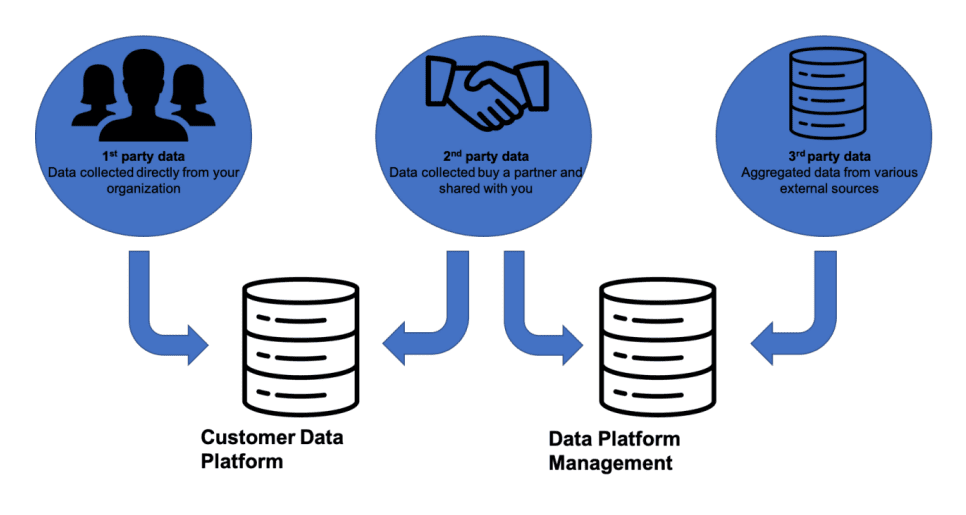Customer Data Platform (CDP) and Data Management Platform (DMP) often create confusion about customer insight and customer segmentation conversations within the organization. Due to the similarity in acronyms of CDP and DMP, there is common confusion regarding those two platforms. This misconception is reasonable given that they both use data to create audiences for marketers. However, what separates the two platforms is the type of data source each one uses, and because of the disparity in data types, they can be integrated differently into your business.
The primary objective of CDP and DMP are similar; however, data quality and its capabilities to support Marketing, Sales, and Customer Success are distinct, and the costs associated due to data volume can be mistakenly enormous.
This article will help you to picture CDP/DMP, and data collected through a few points regarding the definition of the two platforms, differences between CDP and DMP, and clarification of n-party data.
What is a Customer Data Platform (CDP)?
A CDP facilitates the collection, management, standardization, and utilization of consumer data. It will connect all data sources (e.g., your website, CRM, …) to be unified to give a 360-degree view of your customer interaction and to bring to marketing activation or to data analysis.
A customer data platform collects the data that your organization generates through your own applications (1st party data) or from 2nd party data (e.g. from your various partners) in a way for anywhere customers might interact with your business.
In the CDP, the data should be cleaned and can be taken by other tools from your stack for the best effective interaction with your customers.
Some benefits of CDP include:
- Improving your targeting to increase the relevance of your marketing to specific segments of your audience.
- Understanding your customer behaviors/user flow, then forming an appropriate action plan for the product team, MKT team, and sales team to increase the conversion rate.
- Anticipating churning customers by building your propensity model based on user behavior.
- Improving customer experience with a solid A/B testing campaign
- Detecting fraud on anomaly user behavior with Machine Learning
- Increasing the customer satisfaction rate and hence, creating a personalized customer experience
Common use cases for a CDP will be:
- Increase Sales:
The transactional and qualitative data gathered in a CDP can support sales via cross-selling or up-selling by offering personalized discount codes or recommending products matching the customer’s lifestyle.
- Marketing Engagement:
CDP uses identity data in context to give insight into who is interacting with your brand. For that matter, personalization engagement or a solid look-a-like campaign be created.
- Customer retention:
As the CDP is a collection event of your user, that will give you a good understanding of user behavior, and that can be used to predict a churn through a propensity model.
Suppose you are willing to not build with your team or your data analytics expert vendor. In that case, you can still find some CDP solutions ready to be implemented, such as Treasure data, Twilio segment, 6sense, etc. Choose them carefully with some criteria like pricing model to support the growth of the business, scalability, and machine learning integration.

What is a Data Management Platform (DMP)?
In marketing, a DMP gathers and manages vast amounts of anonymized second and third-party data assets. Organizations invest in those data assets to create audiences for acquisition-focused digital advertising campaigns.
DMPs acquire their data either by purchasing it from data sellers or by having a sizable user base that allows the DMP to combine and anonymize its own data; Those 3rd party data providers collect data on their users, anonymize it, and sell it to advertisers. Facebook is one of the best examples of a DMP.
The DMP will provide a user pound based on the segmentation of your target group rather than PII. And the data quality is controlled by the data provider, while you will have no control over the segmentation and aggregation.
By integrating a DMP in your business, here’re what you can take advantage of:
- Finding new markets by accessing a vast amount of user profiles.
- Ability to develop attribution models for inventory and channel sources and understand what is working
- Integration with DSPs
- For marketing, a DMP provides you with a broader sense of direction when deciding the placement of ads and promotional materials.
The main use case of DMP is to improve the advertiser’s online media campaign performance by integrating with a DSP. DSP and DMP will sync up together to allow the tracking of the user across different websites and mobile apps for targeting and re-targeting.
There are various DMP providers such as Lotame, Abode Audience Manager, Roku (ex-DataXu), Amobee, and for every product you want to integrate into your business, ensure that the DMP will provide the data-oriented to your business in terms of audience segmentation. Your marketing team or your Digital Marketing agency might be able to support the choice.
Customer Data Platform vs. DMP: How do they differ?
Since you now understand those platforms are different solutions to help your organization in your business growth and sustainably of your customer base, opposing them makes no sense. Nevertheless, you might need to employ both of them as part of MarTech (the marketing technology stack).
If you want to gather and use first-party data systematically for various goals, such as A/B testing, building the audience, or simply gaining customer insights to provide a better customer experience, CDP is worth considering.
On the other hand, implement a DMP if you want to use third-party audiences to inform targeting in your digital advertising campaign.

Collected Data differs in platforms
As mentioned above, CDPs primarily use first-party data and a small amount of second-party data. DMPs mostly use third-party data, also with some second-party data.
These three categories of data differ in how they’re collected:
1. First-party data
This is data collected by your company.
For example:
Some visitors to your website subscribe to your email newsletter. Their email address is the first-party data that was collected by your company.
Clients make orders, and your company will collect their geo interaction directly and what they like based on purchases from your application.
They are both first-party data.
First-party data is generally the most valuable data for gaining insights regarding customer experience and the safest type of data to collect as you can control the data input, where it came from, and why it was collected.
On the other hand, it’s crucial that you have an audit of your first-party data to ensure the gap in information by the lack of qualitative data input from your website or your applications. Proving that your data was gathered ethically will decrease your chances of privacy violations.
2. Second-party data
This is first-party data collected by another company and shared or sold to a non-competitive partner.
For example:
You partner with another company to sell your product; they will be able the share the consumer data details with your organization (Email, gender, delivery place, the product sold, etc.). That detailed information is their first-party data, but to you, it’s your second-party data.
As this type of data comes from a partner, it’s not as high quality or as safe as first-party data because you can’t prove it was collected ethically. Your partner can prove that, but you cannot.
3. Third-party data
This is data that is collected by a data-collection company and then shared with anyone who wants to purchase it.
Third-party data is generally the worst quality data to use. Data-collection companies typically don’t verify or even guarantee the accuracy of their data. On top of that, it’s hard for you, as a marketer, to prove that this data was collected ethically.
Each third-party provider has its specialties that depend on where and how data are collected. Before engaging a data provider, ensure their reputation and if their data collection will fit with your business or industry.
First-party data tends to be the most helpful and valuable for companies. Third-party data can still be valid, but the fact that it is available to anyone makes it less useful: You and your competitors could use the same third-party data to run your marketing campaigns. That’s not possible with first-party data.

There can be some overlap between second-party data for both CDPs and DMPs while a DMP rarely uses first-party data, and a CDP rarely uses third-party data.
Conclusion
CDP in many firms is a key success to business growth and improving operation ROI. Before building CDP, having a clear vision of where you would use it to interact with your business is necessary. You should also have access to experts who can offer business integration suggestions in addition to technological advice. Don’t be afraid to connect with them; that will save time and money at term.
—
Written by Damien Velly — Data & Analytics Director of KMS solutions.
Subscribe to our newsletter to get the latest updates on data & analytics.







